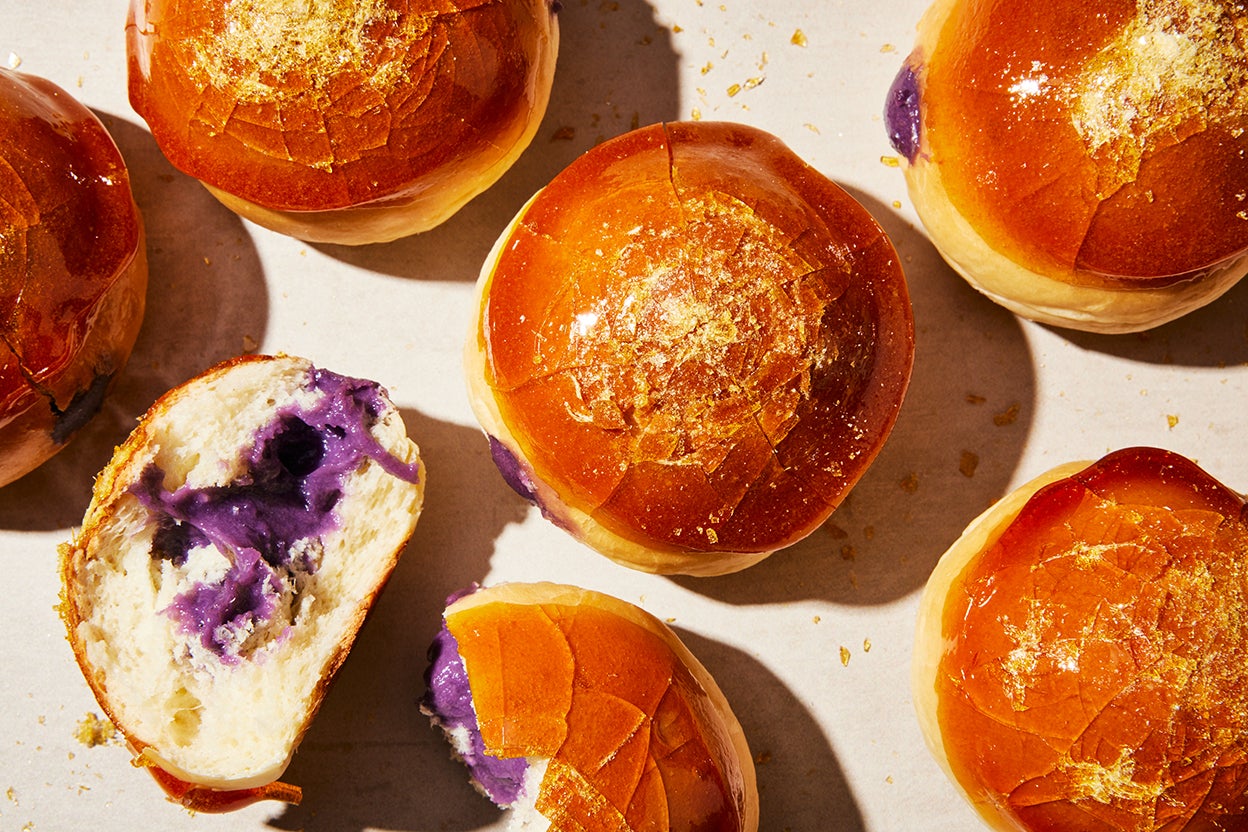Ube Bibingka Custard Buns
4.5
(2)
Your folders
Your folders
Prep Time: 1 hours, 25 minutes
Cook Time: 16 minutes
Total: 2 hours, 25 minutes
Servings: 12
Author : King Arthur Baking

Ingredients
Export 13 ingredients for grocery delivery
Instructions
To make the buns: Gently deflate the milk bread dough and divide it into 12 equal pieces (about 56g each). Roll the pieces into balls and place them on a parchment-lined baking sheet. Cover the pan and allow the buns to rise for 30 to 40 minutes, until puffy. , While the dough is rising, prepare the pastry cream and bibingka. , To make the pastry cream: In a medium saucepan, whisk together the sugar, cornstarch, flour, and salt. Add the egg yolks and stir them into the sugar mixture with a flexible spatula until it looks like coarse, wet sand. Add about 1/4 cup (roughly 57g) of the milk, whisking to break up any large clumps of dry ingredients, then gradually stream in the remainder, whisking until homogenous, with no dry bits at the bottom of the pot. Set the pan over medium heat and whisk for 6 to 8 minutes, until the pastry cream begins to bubble and dramatically thicken. Remove from the heat and whisk in the vanilla and cold butter until the mixture is silky and smooth., Pour the pastry cream into a bowl or container and cover with plastic wrap or parchment directly touching the surface (this prevents a skin from forming) until ready to use., To make the bibingka: Preheat the oven to 350°F. , Lightly grease an 8" round pan, line the bottom with a parchment round, and lightly grease the parchment. In a medium bowl, mix the flour, sugar, baking powder, and salt together until combined. In a large bowl, mix the remaining ingredients until combined. Gradually add the dry ingredients to the wet ingredients while constantly whisking; whisk until the batter is fully homogenous and lump-free. Pour into the prepared pan., Bake for 12 to 14 minutes, or until the bibingka is firm to the touch and the center no longer jiggles. Let cool completely in the pan. (It will be a very thin cake.) Set aside while you return to the milk bread buns., Brush the risen buns with milk and bake for 14 to 16 minutes, still at 350°F, until golden brown; a digital thermometer inserted into the center should read at least 190°F. Let cool to room temperature on the baking sheet. , To assemble: Insert a piping tip, the handle of a spoon, or a chopstick into the side of each bun, about halfway through. Wiggle the tool around assertively to make a cavity for the filling (your aim is to displace a lot of the bread in the center to make room). Fit a pastry bag with a round tip or cut the corner of a plastic bag to make a 1/2" opening. , Crumble or tear the cooled bibingka into pieces and place in the bowl of a stand mixer fitted with the flat beater attachment. Add the pastry cream and mix on medium speed until homogenous, 3 to 4 minutes; some small pieces of bibingka are OK, but the mixture should be mostly smooth. , Fill the prepared pastry bag about half full with filling and pipe it into the buns: Start with the tip of the piping bag inserted into a bun and release pressure while pulling it out, then repeat with the remaining buns. (Try to fill the buns with about 2 to 3 tablespoons, roughly 35g to 40g, of filling and work quickly: The filling thickens as it sits.) , To make the caramel topping: Place a heavy-bottomed saucepan over medium heat and sprinkle in about 1/4 cup (roughly 50g) of the sugar. As the sugar melts, tilt the pan to equally distribute it across the surface. Sprinkle more sugar into the pan as the granules melt, repeating until all the sugar has been added. , Continue to cook the caramel until it’s light amber, with no sugar chunks remaining; when you tilt the pan, it should move like syrup. (If the caramel is too hot, it will smoke and burn and move around the pan like water. If the caramel is too cold, it will stay thick and will be difficult to dip — adjust the heat accordingly.) , To dip the buns: Take a bun in your dominant hand and hold it face down. Keep the heat on the lowest setting possible and tilt the pan with the caramel so that it pools to one side. Use tongs or your hands to quickly dip the top of the bun into the caramel. Lift it up, letting the excess drip back into the pan, and very carefully transfer the bun back to a baking sheet to cool. Use caution when working with hot caramel; if it touches your skin, it’ll burn. , After the caramel cools, use a serving spoon to smack the tops of the buns to crack the caramel. Serve the ube buns immediately, when they’re at their best. , Storage information: Filled ube buns can be refrigerated for several hours before they’re dipped in the caramel. The caramel will lose its crunchy texture over time due to the moisture in the air, so dip only before serving for best results.